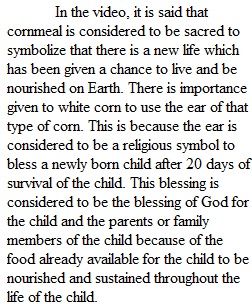


Q Anthropology 102 - Introduction to Cultural Anthropology – D. Earle - Fall 2020Activity Assignment No. 2 – 15 pointsCultural Ecology and the Hopi.In the first part of Unit 2, we have revisited the concept of Cultural Ecology, that was introduced in Unit 1. Cultural Ecology focuses on how a particular culture adapts to getting necessary food and other resources from the environment that it is situated in, using specific cultural skills and practices. Cultural Ecology includes several elements. First, the study of how a cultural group has identified possible resources that a human group can take advantage of, and has developed techniques for getting access to and processing and using those resources. Using the resources may have to do with both securing a food supply and accessing materials for craft activities – clothing, tools, furnishings, and shelter. Second, understanding how this exploitation of specific food and other resources from the environment affects other aspects of the lifeways of a cultural group. These include the following: (1) The size of the local population that available food resources can support (carrying capacity). (2) The settlement arrangements on the landscape that a particular group has (for example, moving around in temporary camps or settled down in a permanent village). (3) The kinds of family and kinship arrangements that a cultural group has – thus differences in family arrangements between groups that do mobile hunting and gathering, mobile herding of animals, settled down irrigation agriculture, and so on.In addition, many cultural beliefs are related to how a cultural group exploits its environment and makes a living. These beliefs may include statuses and roles that are recognized as important in a particular group, attitudes towards work, beliefs about ‘sharing resources’ and cooperation, and ideas about sources of social conflict and fighting over resources. The religious beliefs of a culture are also frequently connected to their economic exploitation of the environment. Both human groups that do hunting and gathering and those that plant crops or are animal herders may recognize many spiritual aspects of the natural environment, including gods and spirits. It is believed that these supernaturals may regulate human interaction with the environment, such as limiting over-hunting, or providing rainfall to water crops. Thus both food-getting and even the preparation and eating of food can be related to supernatural beliefs. The Hopi are a well-known Native American group of Puebloan culture. The Hopi live on Black Mesa in northeastern Arizona, in a desert habitat that has presented a challenge for survival through corn farming for the last thousand years. We have emphasized that the culture, religion, and fiesta system of the Hopi have all been oriented toward cooperation and unity between individuals and clans. This cultural orientation has everything to do with the difficult task of surviving through corn farming in an arid environment. The Hopi had developed special strange-looking corn plants, adapted to windy desert conditions, that are low to the ground and have really long roots. A feature of the “unity” of the Hopi clan groups is the fact that the members of different Hopi clans belonged to the same secret societies that honor the katsina spirits. So Hopi fiestas were not about status rivalries between clans, but about clan members worshipping together as fellow members of individual secret societies. This is still the case today. The assigned video discusses how the Hopi made a living from their environment and how that is reflected in their culture and religious beliefs. It is also important to note that the Hopi, like most other Native American cultures in North America that farmed corn, had a family system that emphasized the female descent line. Membership in the corporate family group was passed from grandmother to- granddaughter, and not through the male line. This appears to have reflected, in part, the importance of females in doing corn farming and in processing the corn for human consumption. This would be an example where how a group made a living- in this case, corn farming and processing- affected family and kinship arrangements.You will provide a brief discussion of the following questions:(1) What is said in the video that suggests a religious importance of corn?(2) What does the video suggest about why the farming of corn may be difficult or unpredictable?(3) What does the video say about kitchen preparation of corn and corn dishes?(4) What are the katsina/ kachina spirits and why are they believed by the Hopi to be important for producing corn?(5) How is the corn harvest prepared or processed after it is picked? Please remember to have your name and class number on your write-up, and you can submit it to me by way of email. It is also a good idea to have a brief version of the assignment name and your first initial or name and your last name included in the computer file name that you use in submitting this assignment.
View Related Questions